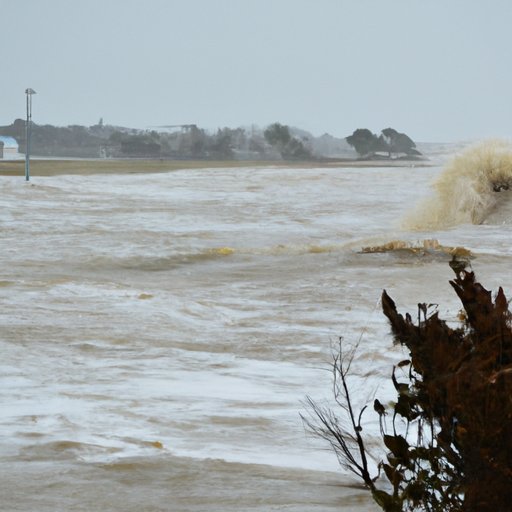Introduction
A storm surge is an abnormal rise in seawater levels caused by high winds and low pressure associated with a tropical cyclone or other severe storm. It can cause extensive flooding in areas near the coast, leading to significant damage to homes, businesses, and infrastructure. As such, it is one of the most destructive forces of nature, and understanding its reach and impact is critical for protecting vulnerable communities from its devastating effects.
Exploring the Potential Reach of Storm Surge: An Overview
In order to better understand the reach of storm surge, researchers have studied historical data and mapped out the potential geographic areas impacted by these powerful storms.
Analyzing Historical Data
According to a study by the National Oceanic and Atmospheric Administration (NOAA), storm surge is the leading cause of death related to hurricanes and tropical storms. The study found that since 1963, more than half of all hurricane-related deaths were caused by storm surge. The study also noted that the greatest number of deaths occurred in the United States and Puerto Rico, where storm surge is a major threat to coastal communities.
Mapping the Potential Geographic Impact
Researchers at the University of Florida used computer models to map the potential geographic reach of storm surge from various types of storms. They found that storm surge could potentially reach up to 20 miles inland from some coasts, depending on the strength of the storm and other factors. Additionally, the researchers found that certain regions are more susceptible to storm surge than others, particularly those with shallow waters and wide bays.

Examining the Factors That Influence the Path of Storm Surge
There are several factors that can influence the path of storm surge, including wind direction and speed, wave action, tides, and currents. Each of these factors can affect the amount of flooding and destruction caused by storm surge.
Wind Direction and Speed
The direction and speed of the wind can determine how far storm surge will travel and how much flooding it will cause. Strong winds can push storm surge farther inland, while weaker winds can limit its reach. According to a study published in the International Journal of Disaster Risk Reduction, wind speed is the most important factor in determining the reach of storm surge.
Wave Action
Waves created by strong winds can also contribute to the reach of storm surge. As waves move toward shore, they can push water farther inland, increasing the potential for flooding. A study published in the Proceedings of the National Academy of Sciences found that wave action can increase the reach of storm surge by up to 30%.
Tides and Currents
Tides and ocean currents can also influence the path of storm surge. Tidal cycles can cause water levels to rise and fall, which can increase or decrease the reach of storm surge. Similarly, ocean currents can carry storm surge farther inland, as well as away from shore.
Investigating the Long-Term Effects of Storm Surge on Local Ecosystems
In addition to the destruction of property and infrastructure, storm surge can have long-term impacts on local ecosystems. These impacts include damage to natural habitats, displacement of wildlife, and flooding of coastal areas.
Damage to Natural Habitats
Storm surge can cause extensive damage to natural habitats, such as coral reefs and mangrove forests. According to a study published in the journal Nature Climate Change, storm surge can lead to the destruction of up to 90% of coral reefs in a given area. Additionally, it can wash away the protective roots of mangrove trees, which can leave them vulnerable to erosion.
Displacement of Wildlife
Storm surge can also displace wildlife, particularly marine animals. For example, a study published in the journal Science found that storm surge can cause fish and other aquatic species to flee their habitats in search of safer areas. Additionally, storm surge can inundate nesting grounds, causing birds and other species to abandon their eggs.
Flooding of Coastal Areas
Finally, storm surge can lead to flooding of coastal areas and the destruction of buildings, roads, and other infrastructure. According to a study published in the journal Environmental Research Letters, storm surge can cause flooding up to 10 meters above sea level in some areas. This can put entire communities at risk of inundation and destruction.
Conclusion
Storm surge is a major threat to coastal areas around the world. Its reach and impact can vary depending on the strength of the storm, wind direction and speed, wave action, tides, and currents. Additionally, storm surge can cause long-term damage to local ecosystems, including destruction of natural habitats, displacement of wildlife, and flooding of coastal areas. Mitigation efforts, such as early warning systems and evacuation plans, are essential for minimizing the impact of storm surge and protecting vulnerable communities.
(Note: Is this article not meeting your expectations? Do you have knowledge or insights to share? Unlock new opportunities and expand your reach by joining our authors team. Click Registration to join us and share your expertise with our readers.)
